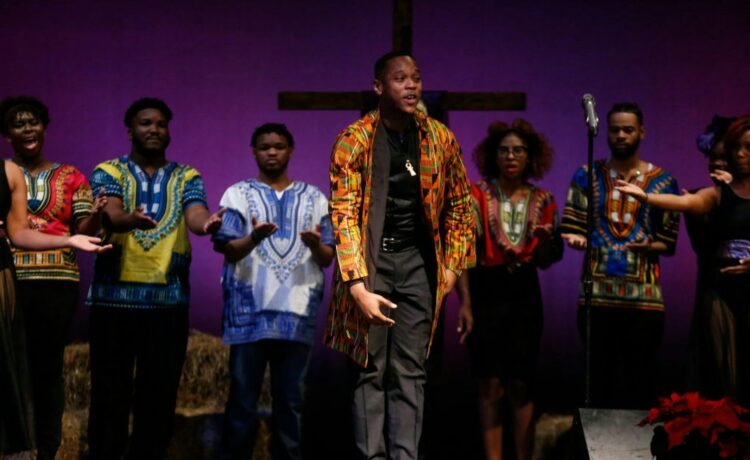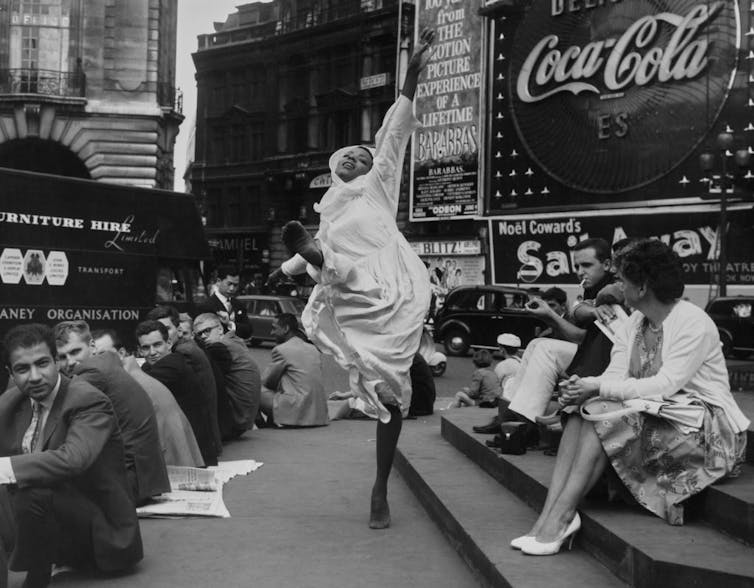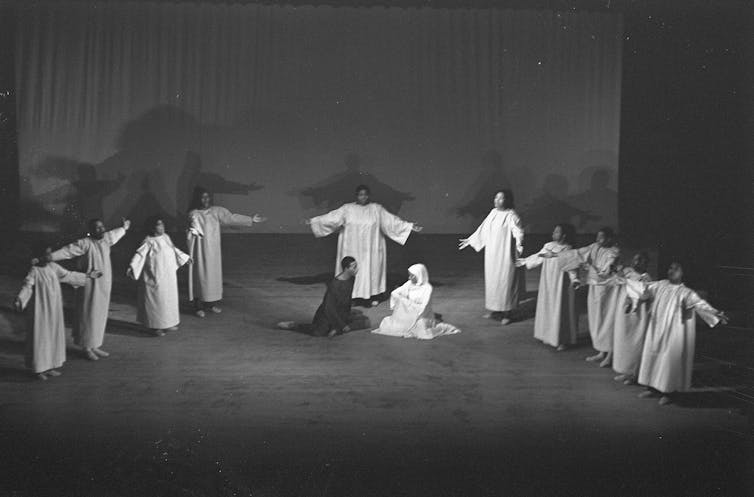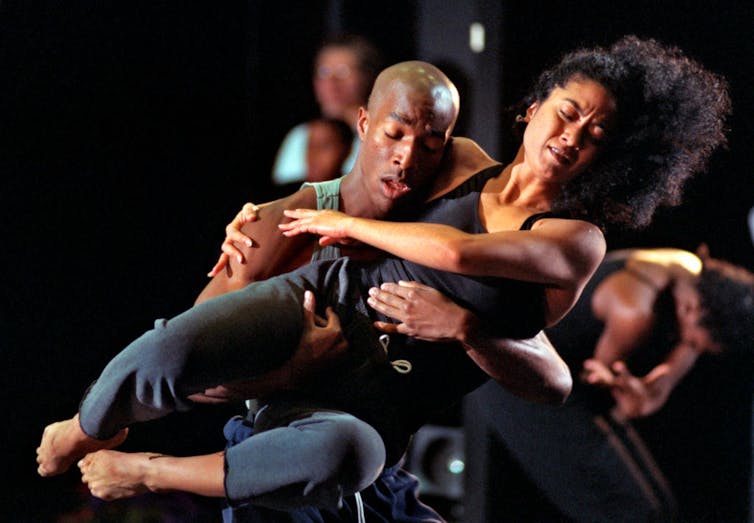More than 60 years later, Langston Hughes’ ‘Black Nativity’ is a pillar of African American theater

(The Conversation) — During the end of every calendar year, a particular holiday performance pops up in African American communities and cultural centers across the nation. “Black Nativity” is a cherished cultural tradition to some and completely unknown to others.
One wonderful yet confounding thing about this show is that depending on where you see it, you will see significantly different productions – from Intiman Theatre in Seattle to Penumbra Theatre in St. Paul or the National Center of Afro-American Artists in Boston.
This might seem counterintuitive, but it is exactly what was intended by the author: Langston Hughes.

The poet’s Christmas play was first produced in 1961.
Charles A. Smith/Jackson State University/Historically Black Colleges & Universities via Getty Images
1 artist, 2 movements
Hughes, a noted although still underappreciated writer, is often associated with the Harlem Renaissance just after World War I, which spurred the growth of jazz. This era – when he penned some of his most famous poems, such as “The Negro Speaks of Rivers” – was the first African American arts movement since Emancipation.
But Hughes is one of a handful of artists whose work spanned both the Harlem Renaissance and the Black Arts Movement of the 1960s and ’70s, which partnered with the modern Civil Rights Movement. In 1961, when Hughes created “Black Nativity,” the Black Arts Movement was still in its infancy, but its early ethos was in the air.
Back in the 1920s, civil rights leader W.E.B. DuBois developed the Krigwa Players, a group that originated in Harlem but had satellite organizations in Cleveland, Baltimore, Philadelphia and Washington, D.C. The objectives of the Krigwa Players, published in the NAACP’s Crisis magazine, were that African American communities create art “for us,” “by us,” “about us” and “near us.” As Black consciousness grew and evolved in the 1960s, however, Black artists wanted to go beyond that criteria. They wanted to place African American life in all corners of existence, including ideas that were imposed on Black culture and transforming them to empower Black people.
Hughes’ desire to write “Black Nativity” was his attempt to reclaim the story of Jesus’ birth for African Americans – to show the son of God, the ultimate salvation, emerging from the Black community. American notions of Jesus were almost always depicted as white, with just a few exceptions. Hughes’ play, on the other hand, called for an entirely Black cast, including the mother and father of Jesus.

Dancer Cristyne Lawson, who performed in a London production of ‘Black Nativity’ in 1962.
Daily Express/Pictorial Parade/Archive Photos/Getty Images
Freedom and flexibility
Moving people from the margins of a story to the center can prompt artists to find more creative forms. What Hughes developed was less like a simple, straightforward narrative and more like jazz, with improvisation at its center.
The playwright wanted to make a production with elasticity: a ritual with a basic frame, but plenty of flexibility. Hughes started to experiment with this ritual form in his 1938 play “Don’t You Want to Be Free?” performed by the Harlem Suitcase Theater. The play used African American history as a frame, calling to unite poor Black and white people to fight the exploitation of the rich.
“Black Nativity,” originally titled “Wasn’t That a Mighty Day,” is rooted in gospel music. The 27 songs in the original text serve as a sonic framing tool. It was to have a large choir – 160 singers strong, in the first production – as well as a narrator, and two dancers to embody Mary and Joseph. The script calls for “no set (only a platform of various levels,) a star and a place for a manger.”

A production of ‘Black Nativity’ in Rotterdam, the Netherlands, in 1962.
Eric Koch/Dutch National Archives via Wikimedia Commons
Hughes was an appreciator of modern dance and enlisted two of the best to hold the roles of Joseph and Mary: Alvin Ailey and Carmen de Lavallade. Yes, that Alvin Ailey, who went on to found one of the country’s most famous dance ensembles.
By all accounts, the dances that Ailey and de Lavallade constructed were brilliant – but were never seen by the public. The pair quit the show last-minute and were replaced by new dancers who could not use their choreography.
My former professor, the late George Houston Bass, was once Hughes’ secretary. Bass told me that Ailey and de Lavallade left in dispute over the title, which Hughes wanted to change to “Black Nativity.”
Ailey and de Lavallade, however, thought that “Wasn’t That a Might Day” was more inclusive. The dancers felt the show told the story of Jesus, and there was no need to focus on the emphasis on race – not entirely different from debates today. Should we emphasize that Barack Obama was a Black president, or a president who happened to be Black?
‘Black Nativity’ in the 21st century
I directed “Black Nativity” for Penumbra Theatre for a few years, starting in 2008, partnering with the Twin Cities’ TU Dance company.
Lou Bellamy, the founder and artistic director of the theater, told me there were audience members who came back every year. It was a tradition for many families originally from the Twin Cities to come from the four corners of the earth to see “Black Nativity” and visit their relatives – in that order of importance.
He went on to tell me that the audiences liked when we tweaked the show, but we had to keep the frame – including many of the gospel classics from the original, such as “Go Tell It On the Mountain.”

Marion Willis, playing Joseph, and Karah Abiog, playing Mary, rehearse for a Penumbra Theatre Company production of ‘Black Nativity’ in 2000.
David Brewster/Star Tribune via Getty Images
In the original text of the play, the narrator told the story of Joseph traveling to Bethlehem with his pregnant wife, because Emperor Caesar Augustus had required that everyone be taxed. It starts with Mary and Joseph looking for a room.
In my version, the interior narrative centers on an upper-middle-class Black family that is visited by a stranger who helps them find the true meaning of Christmas. Mary and Joseph are a truly extended part of the family who show up with the stranger and need a place for the holidays. They are not left to a manger, but brought into a home – prompting the audience to reexamine how to welcome the Lord into their homes and hearts.
Bellamy, the artistic director, also said that I had a responsibility to the theater’s bottom line. He pulled out a spreadsheet and showed me the proceeds of the previous year’s mounting. I believe Bellamy’s quote to me was, “I don’t care if you put the devil in the middle of it. We have to make this number.”
Financially, Hughes’ ritual play has become fuel for African American cultural institutions to maintain themselves. Penumbra, for example, has been an anchor in the Rondo neighborhood of St. Paul for almost half a century. “Black Nativity” is also an anchor for the National Center of Afro-American Artists, which has produced its own version since 1968; Karamu House in Cleveland; the Black Theatre Troupe in Phoenix; and many more.
The flexibility of this play and the resilience of these institutions is why “Black Nativity” is still here – and will stay for a long time. Hughes’ vision allows for African American theaters as old as Karamu House, the nation’s oldest, or the newest playhouse today to make their own “Joy to the World.”
(Dominic Taylor, Acting Chair of Theater, School of Theater, Film and Television, University of California, Los Angeles. The views expressed in this commentary do not necessarily reflect those of Religion News Service.)
![]()
You Might Also Like
New book calls for authentic engagement and equity in organizations
The Nine Asks by Kimberly Danielle Organizations have a responsibility to ensure that people who come there to work, worship,...
‘Holy Hurt’ is Hillary McBride’s field guide to the shattering impact of spiritual trauma
(RNS) — Trauma is a lot like having a shard of glass in your hand, explains clinical psychologist Hillary McBride....
So You Married a Priest? + Beth Allison Barr
It’s ministry by marriage. Did you know there are piles of guidebooks meant to help women excel at...
Abyssinian Baptist Church welcomes dismissal of pastor candidate’s discrimination suit
(RNS) — A federal judge has dismissed a gender discrimination lawsuit brought against Abyssinian Baptist Church by a onetime candidate...









